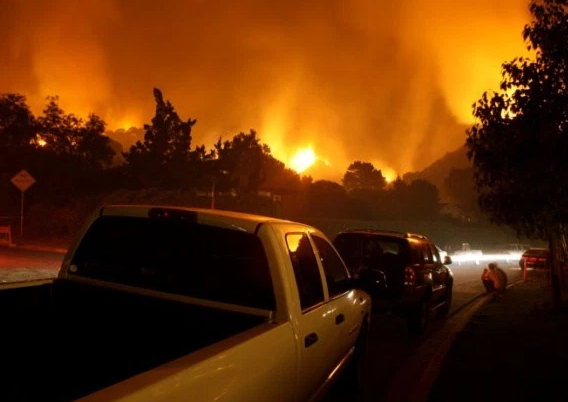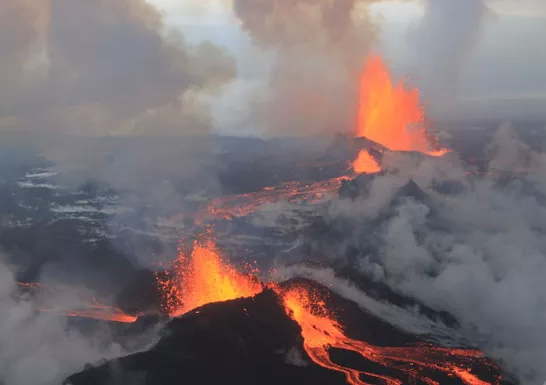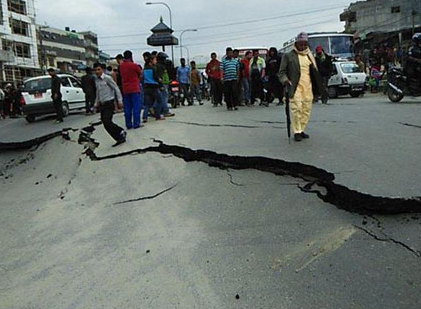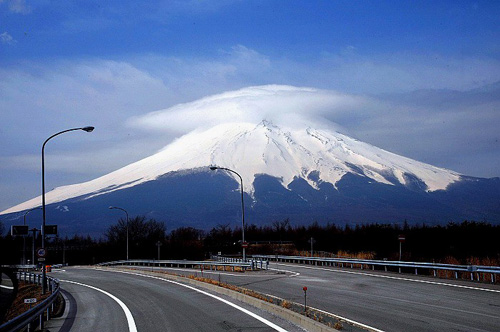Every year brings new hurricanes, tornadoes, earthquakes, and other natural disasters to the world. Although some areas are impacted more often by these natural disasters than others, most people fear extreme weather. Scientists that study these natural disasters have been predicting major storms and occurrences for centuries. Within the 21st century, many have made predictions of major natural disasters occurring in the near and distant future. Here are 10 catastrophic natural disasters that, according to scientific evidence, may occur at any minute. (The entries are listed from least to most impactful.)
世界上每年都会发生飓风、龙卷风、地震等自然灾害。尽管有些地区经常受到自然灾害的影响,但大多数人仍然对极端天气感到恐惧。几个世纪以来,研究这些自然灾害的科学家一直在进行大规模风暴及其他灾害的预报工作。21世纪,很多科学家预言,一些严重的自然灾害将在近期或者不久的将来发生。以下是十场特大自然灾害,根据科学数据,它们随时可能发生。(本文按照灾害影响程度从小到大依次列出)
10.Wildfires--US, 2015–2050
10.2015—2050年,美国火灾

Environmental scientists from the Harvard School of Engineering and Applied Sciences (SEAS) predict that by 2050, wildfire seasons in the US will be three weeks longer, twice as smoky, and will burn a larger portion of the West per year. Concurrently, the US Geological Survey and the Forest Service have recorded that since 1999, the acreage burned by wildfires in the US has tripled from 2.2 million to 6.4 million annually, meaning that much more of the US will be up in flames in the near future.
哈佛工程和应用科学学院的环境科学家预测,到2050年,美国的火灾高发季将延长三周,烟雾量将是以前的两倍,西部地区每年的受灾面积将扩大。同时,美国地质调查局和林务局称,自1999年以来,全年火灾受灾面积由220万英亩增加到640万英亩,增长了近两倍,这意味着不久美国将有更多的地区被火焰吞噬。
What has led to this dramatic increase in the US wildfire risk? The answer, according to SEAS, is gradual climate change, which has raised the Earth's temperature, creating conditions that spawn bigger and fiercer wildfires. Dr. Loretta J. Mickley, a senior research fellow in atmospheric chemistry at SEAS, stated that temperature will be the biggest determiner of future fires. The hotter it is, the more likely it is that a fire will start. Ironically, the problem has been exacerbated by the "Smokey the Bear" and Park and Forest Services campaigns to stop all forest fires, halting the natural fire cycle that clears the underbrush out of the forests. With 30,000–50,000 wildfires predicted to occur annually, the US might soon be experiencing its own version of Hell on Earth.
究竟是什么导致美国火灾风险飙升?根据工程和应用科学学院的研究,答案是缓慢的气候变化。它提高了地球温度,创造了条件,能引发规模更大火势更猛的火灾。洛雷塔·J·米克利博士是哈佛工程和应用科学学院大气化学的高级研究员,她认为,温度是未来火灾最大的决定因素。温度越高,发生火灾的可能性越大。讽刺的是,"护林熊"运动和美国公园与林业管理局阻止一切森林火灾的发生,中断了自然火灾循环系统,导致林下灌木丛生,反而使问题恶化。据预测,美国每年将会发生3万到5万次火灾,当地可能很快就要经历美国版的人间地狱。
9.Baroarbunga Volcanic Explosion--Iceland, 2014
9.2014年,冰岛巴达本加火山爆发

This prediction came true within a few weeks of it being made.
这个预言在几周后就实现了。
In August 2014, the Icelandic Meteorological Office increased the risk level for a possible eruption of Baroarbunga, a volcano located in Iceland. The increase was due to hundreds of earthquakes occurring around the site over several days, a good sign of a possible volcanic eruption. Scientists began to predict just what would occur if Baroarbunga erupted. Some said the ice around the volcano would melt, causing flooding. Others said that the eruption would cause additional eruptions throughout 100-meter-long (328 ft) fissures in southwest Iceland, triggering the volcano Torfajokull, which would destroy several major rivers that serve as Iceland's hydroelectric power source. On August 23, 2014, the volcano began erupting underneath the Dyngjujokull glacier. Over the course of the next week, thousands of earthquakes occurred near Baroarbunga and the area surrounding it, and on August 31, its Holuhraun fissure erupted. The Holuhraun fissure erupted for six months, officially ending on February 28, 2015. The fissure emitted, on average, enough lava to fill an American football stadium every five minutes. In the end, the volcano produced 1.5 cubic kilometers (0.4 mi3) of lava and created an 86-square-kilometer (33 mi2) lava field, making the Baroarbunga eruption of 2014 the largest Icelandic eruption since the eruption of Baroarbunga's Laki fissure in 1783.
2014年8月,冰岛气象局提高了巴达本加火山爆发的风险等级。因为几天内周围发生了成百上千次地震,出现了火山爆发的征兆。科学家开始预测火山爆发会导致什么结果。有些人表示,火山爆发后,周围的冰雪消融,会引发洪水。其他人则认为,巴达本加火山爆发会引发冰岛西南部100米(328英尺)长的裂缝喷发,触动雷克雅未克火山爆发,这将摧毁为冰岛进行水力发电的几条主要河流。2014年8月23日,丁久冰川下的火山开始喷发。在接下来的一周内,巴达本加及附近地区发生了成千上万次地震。8月31号,Holuhraun火山爆发,持续了6个月,到2015年2月28日才结束。火山平均每5分钟喷发出的岩浆就足以填满一个美式足球场。最终,火山喷发出1.5立方公里(0.4 立方英里)的岩浆,形成了一个86平方公里(33 平方英里)的熔岩区。2014年巴达本加的火山爆发成为自1783年巴达本加拉基裂缝爆发以来冰岛最大的一次火山喷发。
8.Megathrust Earthquake--Chile, 2015–2065
8.2015-2065年,智利大逆冲型地震

The Chilean earthquake of April 2014 opened fissures that could lead to a magnitude 8.5 or larger earthquake in Chile. On April 1, 2014, a magnitude 8.2 earthquake occurred 97 kilometers (60 mi) off the northwest coast of Chile near the city of Iquique, causing landslides and a tsunami to hit the coast. This earthquake created the possibility for an even larger earthquake for Chile in the near future due to the location of the earthquake.
2014年4月,智利发生大地震,造成的裂缝可能会引发至少8.5级的二次地震。2014年4月1日,在距离智利西北海岸线97千米(60英里)的伊基克市附近,发生了一场8.2级地震,并引发滑坡和海啸。由于地震位置的特殊性,这场地震可能还将在不久后给智利带来一场更剧烈的强震。
The Iquique earthquake originated from a subduction zone where one tectonic plate, the Nazca Plate, is plunging underneath another, the South American Plate. This subduction zone lies within the "Ring of Fire," an arc in the Pacific containing 75 percent of the world's active volcanoes, which causes much of the world's seismic activity. When a tectonic plate moves under another, the faults can come under severe amounts of stress, and any release of tension causes seismic activity, namely earthquakes. The April 2014 earthquake was a "megathrust" earthquake, or a major earthquake caused by the release of tension from a subduction zone. It only relieved 33 percent of the tension on the fault, leaving the rest to be relieved in the near future.
伊基克地震的震源位于纳斯卡板块插入南美板块下方所形成的俯冲带上,而这条俯冲带正好位于环太平洋火山带中——全球75%的活火山都分布在这条位于太平洋的圆弧上,它也是地球上多数地震活动的诱因。当地质板块互相作用时,在巨大的压力下有可能产生断层,并以地震活动的形式将压力释放出来,这就是我们所说的"地震"。2014年4月发生的这次地震属于大逆冲型地震,或者说是俯冲带上压力释放而触发的一次强震。它仅仅释放了断层处33%的张力,而余下的部分则将默默地等待不久后的下一次机会。
7.Twin Earthquake--Japan, 2017
7.2017年,日本双震型地震

Dr. Masaaki Kimura, a seismologist and emeritus professor of submarine geology at the University of the Ryukyus, is currently predicting that another 9.0 magnitude earthquake, very similar to the 2011 Tohoku earthquake, will occur in Japan in 2017. Occurring on March 11, 2011, the magnitude 9.0 Tohoku earthquake struck 372 kilometers (231 mi) off the coast northeast of Tokyo and created a tsunami with 9-meter (30 ft) waves that hit Japan. Dr. Kimura has stated that he predicted the Tohoku earthquake four years before it happened, but his prediction and evidence were ignored by the Pacific Science Congress.
日本地震学家、琉球大学海洋地质学荣誉教授木村政昭博士日前预测,日本将于2017年遭遇另一场与2011年东日本大地震极为类似的9.0级强震。2011年3月11日,一场9.0级地震袭击了距东京东北海岸372千米(231英里)的日本东北部,并引发了海啸,掀起高达9米(30英尺)的海浪。木村博士称,他曾提前4年预测到东北大地震,然而他的预测和论证都被太平洋科学大会所忽略。
His hypotheses have been based upon his concept of "earthquake eyes," regions that have many small earthquakes that are commonly ignored. Dr. Kimura believes that these earthquake eyes are the best predictors of where and when a major earthquake will occur. Earthquake eyes are a portion of his four-step, short-term earthquake prediction method dubbed the "Kimura method." It is currently the only early earthquake prediction method in use, yet it has not been well tested by his scientific peers. Current earthquake prediction is limited to a few seconds of warning.Kimura believes that the new earthquake will begin in the Izu Islands and will be a magnitude 9.0. It will cause a tsunami to hit Japan in a very similar fashion to the Tohoku earthquake.
他的假设建立在"地震眼"的概念基础上,这一概念指的是那些频繁发生不易察觉的小震的地区。木村博士认为,这些地震眼就是强震发生时间和地点的最佳预报器。以其姓名命名的"木村法"地震早期预测法分为四步,而地震眼只是其中的一部分。这也是目前使用的唯一一种地震早期预测法,但尚未经过科学界的检验。当前的地震预测还局限于震前几秒钟的预警。木村相信,新的地震将发生在伊豆群岛,震级9.0级。并且,它也会像东日本大地震那样引发海啸。
6.Mt. Fuji Eruption--Japan, 2015–2053
6.2015—2053年,日本富士山喷发

When the Tohoku earthquake shifted the landmass of Japan, 20 of the 110 active volcanoes in Japan showed increased seismic activity, leading experts to believe one may erupt any day. The Japan Meteorological Agency (JMA) monitors seismic activity and active volcanoes in Japan. Out of Japan's 110 volcanoes, 47 are considered "active," meaning they have erupted in the last 10,000 years or spew gases. Calculations show that Japan should have a major volcanic eruption every 38 years. Currently, 15 "volcanic events" happen annually.
东北部的地震造成日本大陆移动,与此同时,日本境内110座活火山中有20座火山的地震活动增加,这使专家们相信,终有一日这些活火山会爆发。日本气象厅一直在监控地震活动以及日本的活火山状况。在日本的110座活火山中,有47座非常活跃,在近一万年内曾经爆发或喷发过气体。计算结果表明,日本每38年就会发生一次大规模的火山喷发。目前,每年会发生15次"火山活动"。
On the list of 47 active Japanese volcanoes is Mt. Fuji, Japan's tallest volcano, standing at 3,773 meters (12,380 ft). In July 2014, a French and Japanese scientific team released a report claiming that Mt. Fuji is among the volcanoes most likely to erupt, causing concern for many Japanese citizens. Mt. Fuji is located only 100 kilometers (62 mi) from Tokyo. If Mt. Fuji erupted, the team predicts that it would necessitate the emergency evacuation of 750,000 people from Tokyo. The city would most likely be covered in ash.
在47座活火山的名单内就有富士山,它是日本最高的活火山,海拔3773米(12380英尺)。2014年7月,一个法日科学考察团发表报告,称富士山是那些活火山中最有可能爆发的,这引起了日本民众的担忧。富士山坐落于离东京仅100公里(62英里)的地方。这个考察团预测,富士山一旦爆发,将迫使近75万人从东京紧急疏散,而东京也将被灰尘掩盖。
















